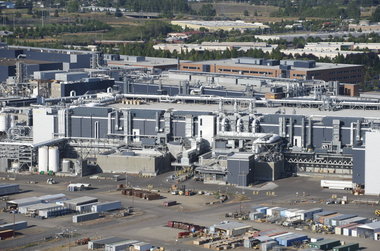HOUSTON—Intel has been busy these days. The computer chip maker is investing between $6 billion and $8 billion to convert existing factories to the next generation of semiconductor manufacturing technology while also building two new chip manufacturing facilities in Oregon and Arizona.
The investment includes construction of a new development fabrication plant (“fab”) at the company’s Ronler Acres Campus in Hillsboro, Ore., to be called “D1X.” (Read more about the building plans here.) The new fab is scheduled for R&D startup in 2013. Upgrades are also planned on four existing factories in Arizona (Fab 12 and Fab 32) and Oregon (D1C and D1D).
To keep a step ahead of the competition, Intel is moving toward using 3D CAD and building information modeling (BIM) for equipment install. “The new building at our facility in Oregon is the first fab at Intel that is designed in 3D,” Jason Hosch, senior industrial engineer at Intel, said at an afternoon session here in the SPAR International conference.
During his presentation on “Lessons Learned Using BIM for a Facility Retrofit at Intel,” Hosch listed a number of benefits of using BIM: Reduced man-hours; reduction in the time between tool set and construction completion; and improved execution and error prevention.
“Prefab of pipes, ducts and wire ways are done off site,” Hosch said. This results in a major reduction in change orders, he said.
That, in turn, results in lower costs. “Lower costs and schedule compression don’t normally go hand in hand,” Hosch said. “We are seeing that, however.”
There is, said Hosch, great potential for large benefits and cost savings, even if the scan-to-BIM workflow can be time consuming. Along the way, Intel learned some valuable lessons. For example, Hosch said, supplier negotiation is critical. It’s important to know what the deliverables will be before work has started.
Further, it’s important that you model all tools being installed in an area. “Include everything in the model,” Hosch said, but “model in order of importance.” This ensures that critical line lengths are met and this decreases the amount of “clashes” and CAD rework.
As you might expect, service provider capabilities vary widely and asset owners should look for those who understand that “BIM is more than just 3D CAD,” he said.
“BIM is more than 3D CAD. BIM is a business process,” Hosch said by way of closing. “You can’t go out and buy BIM. You have to determine what your business process is and go out and find software that fits your business process.”






